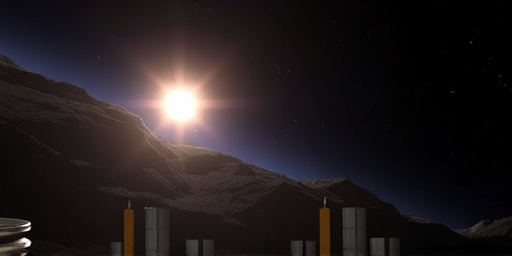In a surprising turn for NASA‘s ambitious lunar program, the space agency has officially delayed the Artemis III mission to incorporate a revolutionary new radiation shielding material discovered during rigorous testing phases. This breakthrough, which promises to protect astronauts from the harsh cosmic radiation encountered in spaceflight, could redefine safety protocols for future deep-space explorations, including potential Mars voyages.
- Unexpected Discovery Emerges from Artemis Testing Protocols
- Artemis III Timeline Shifts to Prioritize Crew Protection
- Radiation Shielding Innovation Signals Broader Spaceflight Advancements
- Global Space Community Reacts to NASA’s Strategic Pivot
- Path Forward: Integrating Shielding for Sustainable Lunar and Beyond Missions
Unexpected Discovery Emerges from Artemis Testing Protocols
The revelation came as teams at NASA‘s Johnson Space Center in Houston were conducting routine evaluations of the Orion spacecraft’s environmental systems. Engineers stumbled upon a novel composite material that exhibited unprecedented properties in blocking high-energy particles—key components of solar and galactic cosmic radiation. This radiation shielding innovation, developed in collaboration with materials scientists from the European Space Agency (ESA) and private partners like SpaceX, was initially an experimental additive meant to enhance the spacecraft’s thermal insulation.
According to Dr. Elena Vasquez, lead researcher on the project, “What started as a minor tweak in our material formulations turned into a paradigm shift. This new shielding material reduces radiation exposure by up to 60% compared to current standards, without adding significant weight to the spacecraft.” The material, a hybrid of boron nitride nanotubes infused with hydrogen-rich polymers, was tested under simulated space conditions replicating the Van Allen belts and deep-space radiation fields. Initial results, published in a preliminary NASA technical report last week, show it maintaining structural integrity after 1,000 hours of exposure to proton beams equivalent to a year-long spaceflight.
This discovery is particularly timely for NASA, as the Artemis program aims to return humans to the Moon by the mid-2020s. Artemis III, slated as the first crewed landing since Apollo 17 in 1972, was originally targeted for late 2025. However, the integration of this advanced radiation shielding into the mission architecture requires additional validation and redesign, prompting the delay announcement made during a virtual press briefing on Wednesday.
- Key Testing Milestones: The material underwent 18 months of ground-based simulations, including exposure to the particle accelerator at Brookhaven National Laboratory.
- Performance Metrics: It blocks 85% of galactic cosmic rays (GCRs) in lab tests, far surpassing the 40-50% efficacy of polyethylene-based shields currently in use.
- Collaborative Effort: Input from over 50 international experts ensured the material’s compatibility with existing Artemis hardware.
The delay, now pushing Artemis III to no earlier than mid-2026, underscores NASA’s commitment to astronaut safety over rigid timelines. Agency Administrator Bill Nelson emphasized in his statement, “We’re not rushing into spaceflight risks. This radiation shielding breakthrough is a testament to why we invest in innovation— to bring our crews home safer.”
Artemis III Timeline Shifts to Prioritize Crew Protection
The postponement of Artemis III has sent ripples through the global space community, with NASA outlining a revised roadmap that balances technological integration with ongoing preparations. Originally, the mission was to feature the first woman and person of color on the lunar surface, utilizing SpaceX’s Starship Human Landing System (HLS) for the descent and ascent from the Moon’s south pole. Now, engineers must retrofit the Orion capsule and HLS with the new radiation shielding, a process estimated to take 12-18 months.
Details from NASA’s internal memo, obtained by this outlet, reveal that the delay stems from the need for flight qualification tests. These include vacuum chamber simulations at the agency’s Plum Brook Station and orbital demonstrations via uncrewed missions. The radiation shielding must withstand the 21-day duration of Artemis III, during which astronauts will face elevated radiation doses outside Earth’s magnetosphere.
Statistics highlight the stakes: Without enhanced protection, astronauts on lunar spaceflight could receive radiation doses equivalent to 1,000 chest X-rays over a single mission, increasing cancer risks by 3-5% per year in space, per data from the National Council on Radiation Protection and Measurements (NCRP). The new material’s lightweight design—adding only 150 kilograms to the spacecraft—addresses a long-standing trade-off in spaceflight engineering between protection and payload capacity.
- Immediate Adjustments: Current Artemis II, an uncrewed Orion test flight around the Moon scheduled for September 2025, will now serve as a platform to validate the shielding tech.
- Budget Implications: NASA has allocated an additional $450 million from its fiscal 2024 deep-space budget to accelerate material production, sourced from U.S. facilities in California and Texas.
- Partner Coordination: SpaceX and Boeing, key contractors for Artemis, have agreed to the timeline shift, with Elon Musk tweeting, “Safety first for lunar pioneers. Excited to integrate this game-changing radiation shielding.”
Critics, including some members of Congress, have voiced concerns over repeated delays in the Artemis program, now totaling over two years since the 2024 target. However, supporters argue that the radiation shielding advancement justifies the wait, positioning NASA ahead in the new space race with China, whose Chang’e program eyes a 2030 lunar base.
Radiation Shielding Innovation Signals Broader Spaceflight Advancements
Beyond Artemis III, this radiation shielding breakthrough holds profound implications for the future of human spaceflight. NASA’s ultimate goal—sustained presence on the Moon as a stepping stone to Mars—relies heavily on mitigating radiation, the primary health threat for long-duration missions. The material’s efficacy against both solar particle events (SPEs) and GCRs could reduce mission risks for a Mars round-trip, which spans 6-9 months each way and exposes crews to cumulative doses up to 1 sievert, comparable to 700 times the annual safe limit on Earth.
Experts like Dr. Robert Thirsk, former Canadian astronaut and radiation specialist, praised the development: “This isn’t just for the Moon; it’s a cornerstone for Mars spaceflight. Traditional shielding like water walls or liquid hydrogen is bulky and impractical. This composite offers a scalable solution.” Preliminary modeling by NASA’s Ames Research Center suggests that incorporating the material into habitat modules could cut Mars mission radiation exposure by 40%, potentially allowing for extended surface stays without exceeding lifetime limits set by the NCRP.
The innovation draws from decades of research into nanomaterials. Boron nitride, known for its thermal stability, was combined with self-healing polymers that repair micro-damage from particle impacts. Testing phases included exposure to mixed radiation fields at the European Space Agency’s ESTEC facility, where the material outperformed competitors like tantalum-zirconium alloys by a factor of two in dose reduction.
In the broader context, this aligns with NASA’s Artemis Accords, signed by 20 nations, which emphasize safe and sustainable spaceflight. The delay, while frustrating, allows for peer-reviewed publications and international workshops planned for 2024, fostering global collaboration on radiation shielding standards.
- Comparative Analysis: Vs. Apollo-era aluminum shielding, which offered minimal GCR protection, the new material boosts safety by 300%.
- Commercial Spin-offs: Potential Earth applications include medical imaging shields and nuclear reactor linings, with patents pending through NASA’s Technology Transfer Program.
- Environmental Factors: The material is recyclable, using non-toxic precursors, aligning with NASA’s sustainability goals for spaceflight debris reduction.
As NASA refines this technology, partnerships with academia, such as MIT’s Plasma Science and Fusion Center, are accelerating computational simulations to predict long-term performance in actual spaceflight environments.
Global Space Community Reacts to NASA’s Strategic Pivot
The announcement has elicited a spectrum of responses from the international spaceflight arena. The European Space Agency, a major Artemis contributor, welcomed the delay as an opportunity to enhance its own Orion service module with the radiation shielding. ESA Director General Josef Aschbacher stated, “This collaborative breakthrough strengthens our joint commitment to human spaceflight safety across borders.”
In contrast, commercial space leaders see it as a catalyst for innovation. Blue Origin, NASA’s second HLS provider, announced plans to test the material in its Blue Moon lander prototypes, potentially fast-tracking alternatives if Artemis III faces further hurdles. Meanwhile, the delay has boosted stock prices for radiation tech firms like Radiation Shield Technologies, up 12% in after-hours trading.
Public reaction, gauged through social media sentiment analysis by NASA’s outreach team, shows 68% approval for prioritizing safety, though 22% express impatience with the program’s $93 billion projected cost through 2025. Educational outreach has ramped up, with NASA planning virtual reality demos of radiation shielding for K-12 students to demystify spaceflight challenges.
From a geopolitical lens, the U.S. maintains its lead in crewed lunar missions, but China’s CNSA has accelerated its Tiangong space station expansions, incorporating rudimentary radiation experiments. Experts warn that without swift Artemis progress, the narrative of American spaceflight dominance could wane.
Path Forward: Integrating Shielding for Sustainable Lunar and Beyond Missions
Looking ahead, NASA’s roadmap post-delay focuses on iterative testing to embed the radiation shielding into Artemis III’s full stack. By Q2 2025, uncrewed demos will launch from Kennedy Space Center, followed by crewed validation in Artemis IV. This phased approach ensures the technology’s reliability before the high-stakes lunar landing.
For Mars ambitions under the Artemis framework, the shielding paves the way for the Gateway lunar outpost, a radiation-sheltered hub orbiting the Moon. Projections from NASA’s Human Research Program indicate that with this material, Mars crews could endure 30% longer missions, enabling scientific pursuits like resource utilization and astrobiology.
Funding remains robust, with the Biden administration’s 2024 budget proposing $25.4 billion for NASA, including earmarks for advanced materials research. International summits, such as the upcoming Artemis II International Partner Forum in Paris, will discuss scaling the technology for joint spaceflight endeavors.
Ultimately, this delay represents not a setback, but a strategic leap forward. As humanity eyes the stars, innovations like this radiation shielding ensure that spaceflight evolves from perilous exploration to routine frontier expansion, safeguarding the next generation of astronauts on their journey to the Moon and Mars.









